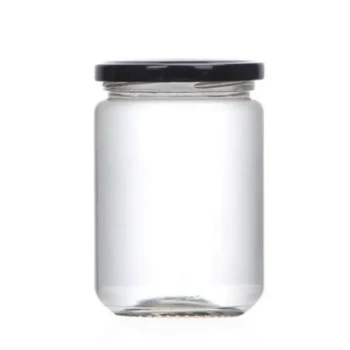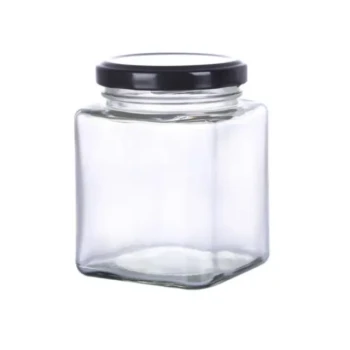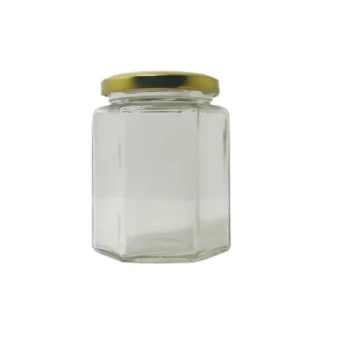At its core, a honey press is a simple and effective machine that uses mechanical pressure to squeeze honey directly from the comb. Unlike centrifugal extractors that spin honey out, a press crushes the entire comb, releasing the honey. This method is particularly well-suited for small-scale beekeepers, hobbyists, or those with specific hive types who prioritize simplicity and versatility over comb preservation.
A honey press functions by crushing comb rather than spinning it. This fundamental difference makes it a cost-effective and versatile tool for specific beekeeping styles, but it requires sacrificing the beeswax comb in the process.
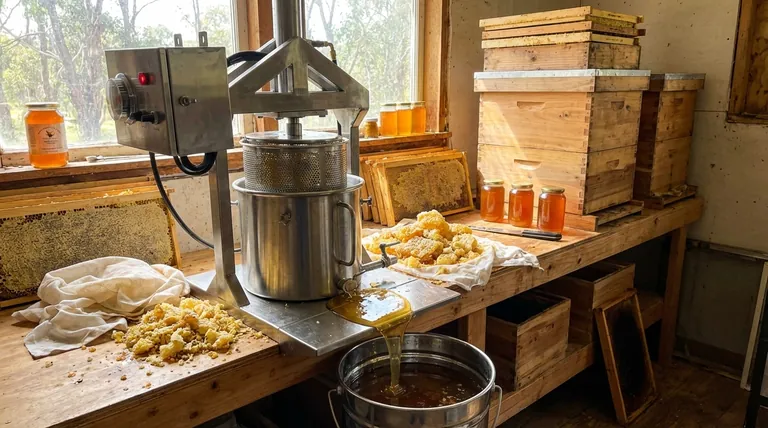
How a Honey Press Works
A honey press operates on a straightforward principle of applying force to extract honey. Understanding this mechanism is key to appreciating its role in an apiary.
The Core Mechanism: Crushing
The most common design is a bucket or basket press. Raw honeycomb is placed into a perforated basket or container. A pressure plate is then lowered onto the comb, typically by turning a large screw handle.
This action exerts immense force, crushing the wax cells and forcing the liquid honey to flow out.
The Collection Process
As the honey is squeezed from the comb, it passes through the perforations in the basket. It is then collected in a receiving container or basin at the bottom of the press.
This process is slow and relies on steady pressure to ensure as much honey is recovered as possible.
The Need for Filtering
Because the press crushes the entire comb structure, the resulting honey contains a significant amount of beeswax particles and other debris.
After pressing, the honey must be filtered to achieve a clean final product. This is typically done by pouring it through layers of cheesecloth or a fine-mesh sieve before bottling.
Who Benefits Most from a Honey Press?
The honey press is not a one-size-fits-all solution. It excels in specific scenarios where its unique characteristics are an advantage.
The Small-Scale or Hobbyist Beekeeper
For beekeepers with only a few hives, the high cost and large storage footprint of a centrifugal extractor can be prohibitive. A honey press is a far more affordable and compact alternative for processing a small harvest.
Warre and Top-Bar Hive Beekeepers
Beekeepers using Warre, top-bar, or other foundationless hives often cannot use traditional extractors because their combs lack the structural support of a rigid frame. A press is one of the primary methods for extracting honey from these natural combs.
Flow Hive Owners with Traditional Frames
While the Flow Hive automates extraction from its specialized frames, beekeepers often manage traditional Langstroth frames for brood or supplemental honey in the same hives. A press provides a simple way to process honey from these non-Flow frames.
Processing Burr Comb and Cappings
A press is an excellent tool for recovering honey from wax cappings (sliced off before extraction) and irregular burr comb that bees build in gaps. This ensures that no honey goes to waste.
Understanding the Trade-offs: Press vs. Extractor
Choosing a honey press involves a clear set of trade-offs compared to the more common centrifugal extractor.
The Critical Difference: Comb Destruction
A press destroys the beeswax comb. Bees expend significant energy and resources (consuming many pounds of honey) to build comb. Reusing drawn comb from an extractor gives the colony a massive head start for the next season. With a press, this advantage is lost.
Advantage: Cost and Simplicity
Honey presses are mechanically simple, making them significantly less expensive than even the most basic manual extractors. Their straightforward operation requires minimal training or complex setup.
Advantage: Versatility
Many honey presses are multi-purpose. Due to their simple, robust design, they can often be used as a fruit press for making cider or wine, adding value beyond the apiary.
Disadvantage: Labor and Throughput
Pressing honey is generally a slower, more labor-intensive batch process compared to the continuous spinning of an extractor. The subsequent need for thorough filtering also adds an extra step to the workflow.
Key Features and Best Practices
To get the most out of a honey press, it helps to understand its features and follow established best practices for its use.
Key Features to Look For
Some presses offer variable pressure control, allowing you to fine-tune the force for different types of comb. Others may include a built-in primary filtering system to separate the largest wax pieces during the initial press.
Practical Tips for Use
For smoother operation, lightly coat the screw threads with a food-grade oil or grease before use. For stability, bolt the press to a sturdy workbench.
It's often more effective to roughly crush the comb before loading it into the press basket, as this helps the honey flow more freely. After use, clean the press thoroughly with warm water and a soft brush to prevent buildup.
Making the Right Choice for Your Apiary
Your specific beekeeping goals should dictate whether a honey press is the right tool for you.
- If your primary focus is on small-scale production or natural comb: A honey press is an excellent, budget-friendly choice that aligns perfectly with the needs of hobbyist, Warre, or top-bar beekeeping.
- If your primary focus is maximizing honey yield and bee efficiency: A centrifugal extractor is the superior choice, as preserving drawn comb saves your bees immense time and energy.
- If your primary focus is on versatility and processing waste comb: A press is an invaluable secondary tool for recovering honey from cappings and burr comb, even if you already own an extractor.
Ultimately, choosing a honey press is a decision to prioritize simplicity and cost-effectiveness for smaller-scale operations.
Summary Table:
| Aspect | Honey Press | Centrifugal Extractor |
|---|---|---|
| Method | Crushes comb with pressure | Spins honey out, preserving comb |
| Best For | Small-scale, hobbyists, Warre/top-bar hives | Larger-scale, commercial apiaries |
| Cost | Affordable, budget-friendly | Higher initial investment |
| Comb Outcome | Destroys comb for wax recovery | Preserves comb for bee reuse |
| Versatility | Often doubles as a fruit press | Single-purpose for honey extraction |
Ready to Simplify Your Honey Harvest?
As a leading wholesale supplier to commercial apiaries and equipment distributors, HONESTBEE provides durable, high-value beekeeping equipment. If you're a small-scale beekeeper, hobbyist, or manage natural comb hives, a honey press from HONESTBEE offers the affordable simplicity and versatility you need.
Contact HONESTBEE today to discuss your equipment needs and discover how our wholesale solutions can support your apiary's success.
Visual Guide
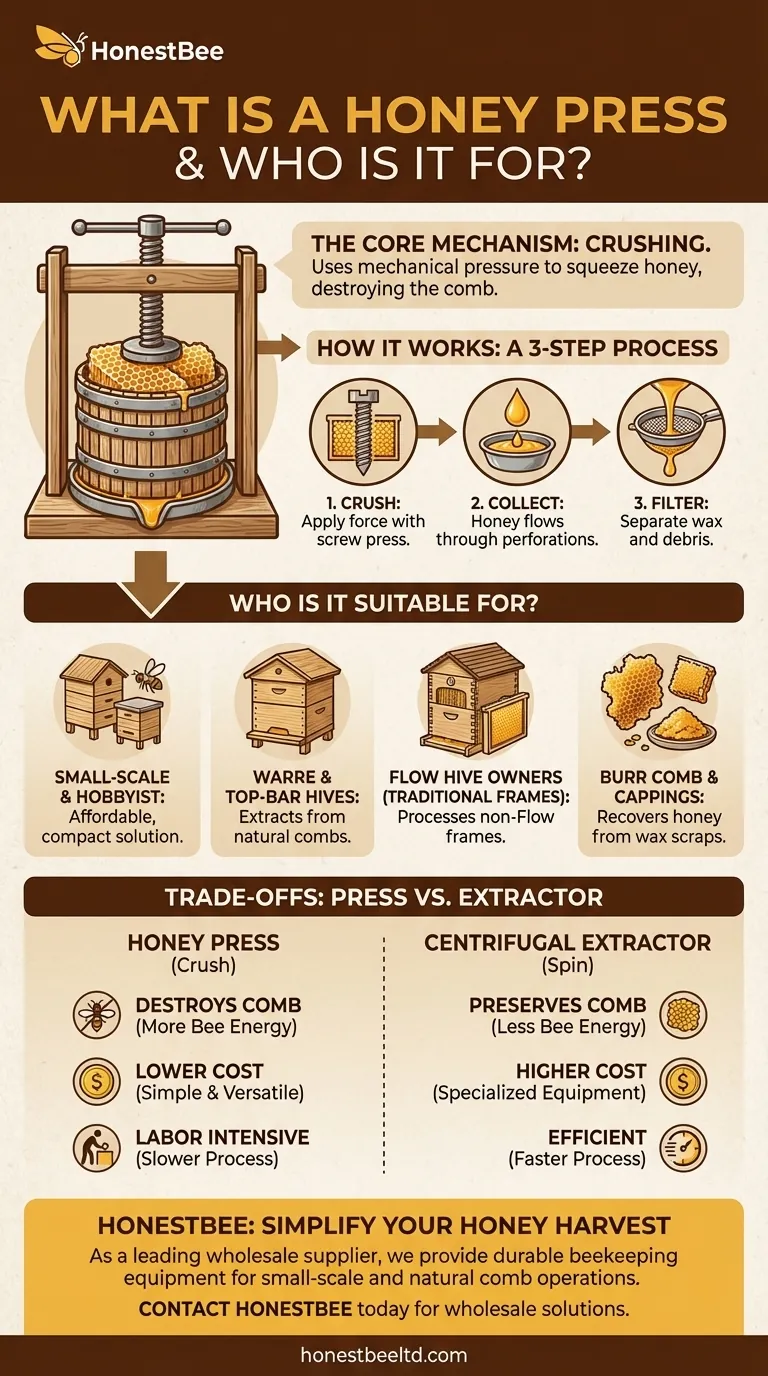
Related Products
- Electric Honey Press Machine for Squeezing Honey Comb Press Equipment
- Easy Use Manual Stainless Steel Honey Press for Honey Comb
- Stainless Steel Manual Honey Press with Guard for Pressing Honey and Wax
- HONESTBEE 3-Frame Manual Acrylic Honey Extractor
- 10L Stainless Steel Electric Honey Press Machine
People Also Ask
- How does using a honey press affect honeycomb reuse? It Destroys Comb but Captures Unique Honey & Wax
- What are the benefits of using a honey press for Warré or Top Bar beehives? Maximize Your Natural Harvest
- How can a honey press be used beyond honey extraction? Unlock Its Full Potential for Your Farm
- How does a honey press work? A Guide to Simple, High-Yield Honey Extraction
- What are the reasons for choosing a honey press over a dedicated honey extractor? Maximize Disease Control and Natural Beekeeping












